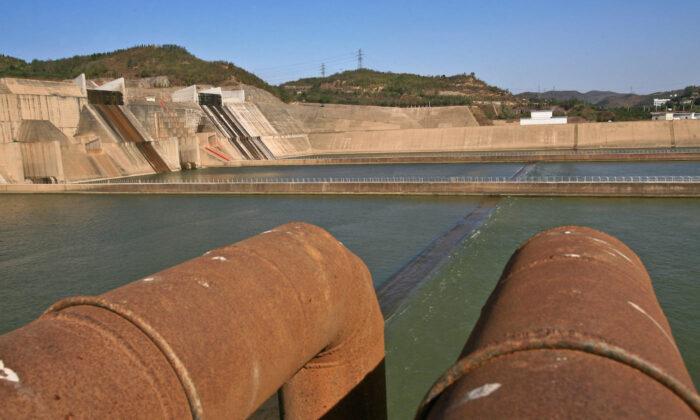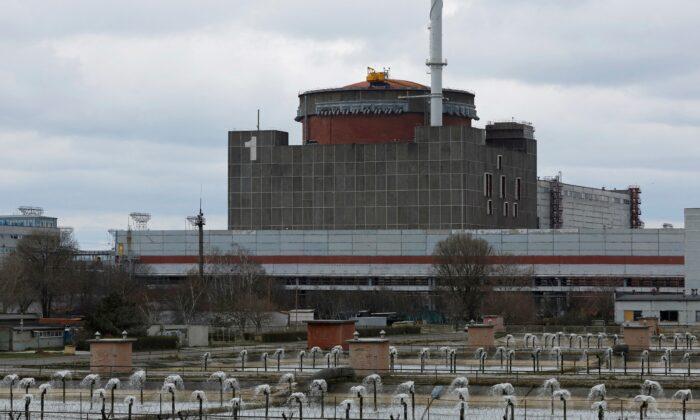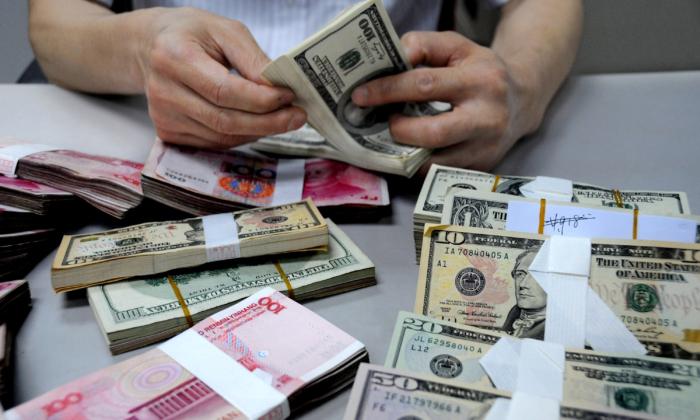Millions of dollars have been spent on dredging and expanding a “dangerously weak” reservoir in central China that was built in 1958 during Mao Zedong’s disastrous Great Leap Forward.
A pilot project, with a reported budget of $490 million, is attempting to resolve long-standing sediment issues in Suyahu Reservoir in Zhumadian City, Henan Province.
Begining in 2018, the Suyahu project plans to dredge 37.75 million cubic meters (9.97 billion gallons) in the reservoir and would be completed in 2022, according to state media China Daily.
Wu Guoding, vice governor of the province, said in March that it’s expected to be a “high-quality project” that will also provide “experience” for the dredging and expanding of other large reservoirs in China.
The reservoir controls a watershed area of 61 percent of the Ru River, a branch of Huai River that originates in Henan Province.
This photo taken Nov. 3, 2014, shows a factory and power poles partly submerged below the Danjiangkou Reservoir in China's central Henan Province. Greg Baker/AFP via Getty Images
But the project and the reservoir have serious issues.
Wang Weiluo, a water resource specialist living in Germany, recently told The Epoch Times that “intercepting sediment in the upstream reservoir might alleviate some problems, but it is just like a relocation from here to there [within the reservoir].”
The inappropriate topography caused the reservoir to be “inherently deficient,” and the problem of sediment accumulation was inevitable from the very beginning, Wang said.
The Suyahu Reservoir is a typical plain reservoir with topography inclining from northwest to southeast. When the water from upstream enters the reservoir, the flow rate decreases, resulting in sediment accumulation, said the Suyahu Reservoir Administration Bureau about the reason for sedimentation in a 2016 report. As the reservoir is built in a low-lying area, the situation deteriorates during flood season, the report said.
“From 1958 to 2007 the Suyahu Reservoir’s capacity reduced about 75.6 million m3 (around 19.9 billion gallons) ... The depth of silt in the reservoir area in front of the floodgate was nearly 3 meters deep in 2007,” the report said.
The siltation of the reservoir worsens year by year.In December 2018, Dong Changxing, the deputy director of the Suyahu Reservoir Administration, said the average water depth in the reservoir was less than two meters, while the average siltation depth reached about one meter.
In May 2020, Liu Xiaowen, deputy mayor of Zhumadian, told Henan Daily Newspaper that “the silt volume is nearly 100 million cubic meters (around 26.4 billion gallons), close to the capacity of a large reservoir.”
As the sediment accumulation in the reservoir is ongoing, water expert Wang said it would continue to cost a lot of money to dredge it in the future.
“Dredging Suyahu Reservoir is a massive investment to correct the [regime’s] mistakes of the past, but it is not the right measure,” Wang said.
“If you spend a lot of money every 20 years to dredge the sediment out, you might solve the problem temporarily,” he said. “But there is a question of economic efficiency here.”
“How to deal with the dredged sediment would be a bigger problem, and if it’s not handled well, the sediment will go back into the reservoir,” Wang said.
“And the reservoir is so polluted that it must be treated to remove the contaminants, and these measures and costs have not been considered.”
Suyahu Reservoir is not the only reservoir in China that has a sediment problem.
“Many of China’s reservoirs have serious sedimentation issues, and this is one of the main reasons why the dams are not safe,” he said.
Water Projects During the Great Leap Forward
Construction of Suyahu Reservoir started March 1, 1958, and it took only 100 days to complete with a storage area of 239 square kilometers said the official media Henan Daily. Some 100,000 people from the surrounding area were mobilized to build it.“The reservoir was part of the ‘Three Sides Project’ during the Great Leap Forward of the Chinese Communist Party,” Wang said.
Three Sides Project refers to the exploration, design, and construction, of a project which is done simultaneously.

Workers load a heavy piece of rock by hand into a conveyor belt as they build a reservoir in China in mid-1958. Express/Archive Photos/Getty Images
In 1957, communist leader Mao declared he would push China to catch up with Britain and surpass the United States economically through his economic and social campaign called the Great Leap Forward (1958 to 1962). Much of it was a bid to transform nature. The campaign resulted in the deaths of tens of millions of Chinese mainly through starvation in what is known as the Great Famine.
“The Suyahu project, the Huai River project, the Three Gorges project, and the South-North Water Transfer project are all examples of the Chinese Communist Party’s barbaric projects,” Wang said.
The Three Gorges Dam spans the Yangtze River of central China, in Yichang city, Hubei Province. The South-North Water Transfer project is a multi-decade project on transferring fresh water from the Yangtze River in southern China to the more arid north where the capital of Beijing is situated.
Earlier on July 24, Wang told Xiao Ming Watching the World that the leading cause of the July flood in Zhengzhou City, Henan Province, was the South-North Water Transfer Project.

A man carries bottled water as he crosses a flooded street in Zhengzhou, a city in China's Henan Province on July 23, 2021. Noel Celis/AFP via Getty Images
Wang also wrote an article in 2003 on the hazards of the South-North Water Transfer Project, saying that the long-distance and large volume of water transferred across rivers would have “a serious impact on the ecological environment of both the sending and receiving areas” and violate “the most basic principles of sustainable development theory”.
Dangerously Weak Reservoirs
“Under the [communist] slogan of ‘Man can conquer nature’ the number of ‘dangerously weak reservoirs’ grew at an average rate of 1,000 per year, and by the early 1970s, the ‘cancer [dangerously weak reservoir]’ had finally spread … nationwide,” said China Geological Environment Information site on July 27, 2005.The site said that so-called dangerous weak reservoirs are defined as reservoirs whose actual flood resistance standard is lower than the national standard, or the project has more severe safety hazards and cannot operate as designed.
Suyehu Reservoir is a dangerously weak reservoir, and the negative effect of the Banqiao Dam failure disaster in the mid-1970s was worse than “cancer,” said Wang.
Typhoon Nina collapsed Banqiao Dam and over 60 other dams in Henan in August 1975, affecting some 10.15 million people, with a death toll estimated to be 240,000.
It was the third-deadliest flood in history.
“The 240,000 victims were not just those who were swept away by the dam collapse, but the floodwaters were blocked by the Suyahu Reservoir and could not be released quickly enough, leaving hundreds of thousands of residents soaked in water, without food or water, and plagued by epidemics,” Wang said.
According to the Ministry of Water Resources statistics on April 22, China has more than 98,000 reservoirs, 80 percent of which were built in the 1950s to 1970s. After the 1998 floods, the cumulative funds allocated to 71,800 dangerously weak reservoirs reached more than 150 billion yuan (about $23.25 billion).





